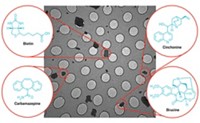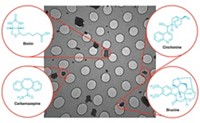Advertisement
Grab your lab coat. Let's get started
Welcome!
Welcome!
Create an account below to get 6 C&EN articles per month, receive newsletters and more - all free.
It seems this is your first time logging in online. Please enter the following information to continue.
As an ACS member you automatically get access to this site. All we need is few more details to create your reading experience.
Not you? Sign in with a different account.
Not you? Sign in with a different account.
ERROR 1
ERROR 1
ERROR 2
ERROR 2
ERROR 2
ERROR 2
ERROR 2
Password and Confirm password must match.
If you have an ACS member number, please enter it here so we can link this account to your membership. (optional)
ERROR 2
ACS values your privacy. By submitting your information, you are gaining access to C&EN and subscribing to our weekly newsletter. We use the information you provide to make your reading experience better, and we will never sell your data to third party members.
Analytical Chemistry
Electron Diffraction Technique Reveals Structure Of Vanishingly Small Protein Crystals
Structural Biology: MicroED yields new information about Parkinson’s aggregates
by Stu Borman
September 14, 2015
| A version of this story appeared in
Volume 93, Issue 36

To determine the high-resolution structure of some biomolecules, scientists use the well-established technique X-ray crystallography. But for that century-old method to work, they must first grow large crystals of the substances—one-tenth of a millimeter thick and larger, in most cases. Some biomolecules, however, are difficult to work with and form crystals that are too small to analyze this way.
A report now shows that a technique called microED (microelectron diffraction) can determine the structures of biomolecules at atomic resolution by probing crystals with only about one-millionth the volume of those needed for X-ray crystallography. In the study, Tamir Gonen of Howard Hughes Medical Institute’s Janelia Research Campus; David S. Eisenberg of the University of California, Los Angeles; and coworkers used microED to determine the structures of aggregates of two peptides from α-synuclein that play key roles in Parkinson’s disease (Nature 2015, DOI: 10.1038/nature15368).
The structures they obtained are similar to those uncovered by research teams studying amyloid-forming peptides involved in other neurodegenerative diseases, notes Michel Goedert of the Medical Research Council Laboratory of Molecular Biology (MRC LMB), in Cambridge, England, in a Nature commentary. But they also provide new information that could aid in the development of potential agents to fight Parkinson’s that inhibit α-synuclein aggregate formation.
X-ray crystallography requires relatively large crystals because X-rays quickly damage small ones, destroying samples before they can be analyzed effectively. X-ray free-electron laser (XFEL) diffraction instruments use ultrafast pulses that can analyze crystals about one-thousandth the volume of those probed by conventional X-ray crystallography, but XFEL instruments are rare and expensive to use. Single-particle cryoelectron microscopy, which has become increasingly popular in recent years, doesn’t require crystals at all but is limited to analyzing only large biomolecules.
In 2013, Gonen’s group at Janelia developed microED, which is in the cryoelectron microscopy family of techniques. The electron beam used by the method interacts with molecules more “softly” than X-rays do but is still damaging. Gonen and coworkers made the technique work by stepping down the power of the electron beam to extremely low levels, permitting sufficient signal to be collected to derive structures.
Cryoelectron microscopy expert Richard Henderson, also at MRC LMB, tells C&EN that microED could fill “a useful structural biology niche” between X-ray crystallography’s big crystals and single-particle cryoelectron microscopy’s noncrystals.
In the new work, the Gonen-Eisenberg team used microED to analyze crystals so small that they can’t be visualized by conventional light microscopy. Gonen’s group has tested microED on enzymes, such as lysozyme, with well-known structures. But the new study is the first to apply the technique to previously unknown structures. MicroED determined the α-synuclein peptide aggregate structures at 1.4-Å resolution—the best resolution ever achieved by any cryoelectron microscopy technique.
Cryoelectron microscopy instruments are relatively inexpensive and already widely available in many laboratories, so crystallographers could eventually use microED routinely. Disadvantages of the technique include an inability to analyze large crystals in addition to small ones and problems with phasing, a process needed to calculate structures.
This article has been translated into Spanish by Divulgame.org and can be found here.





Join the conversation
Contact the reporter
Submit a Letter to the Editor for publication
Engage with us on Twitter